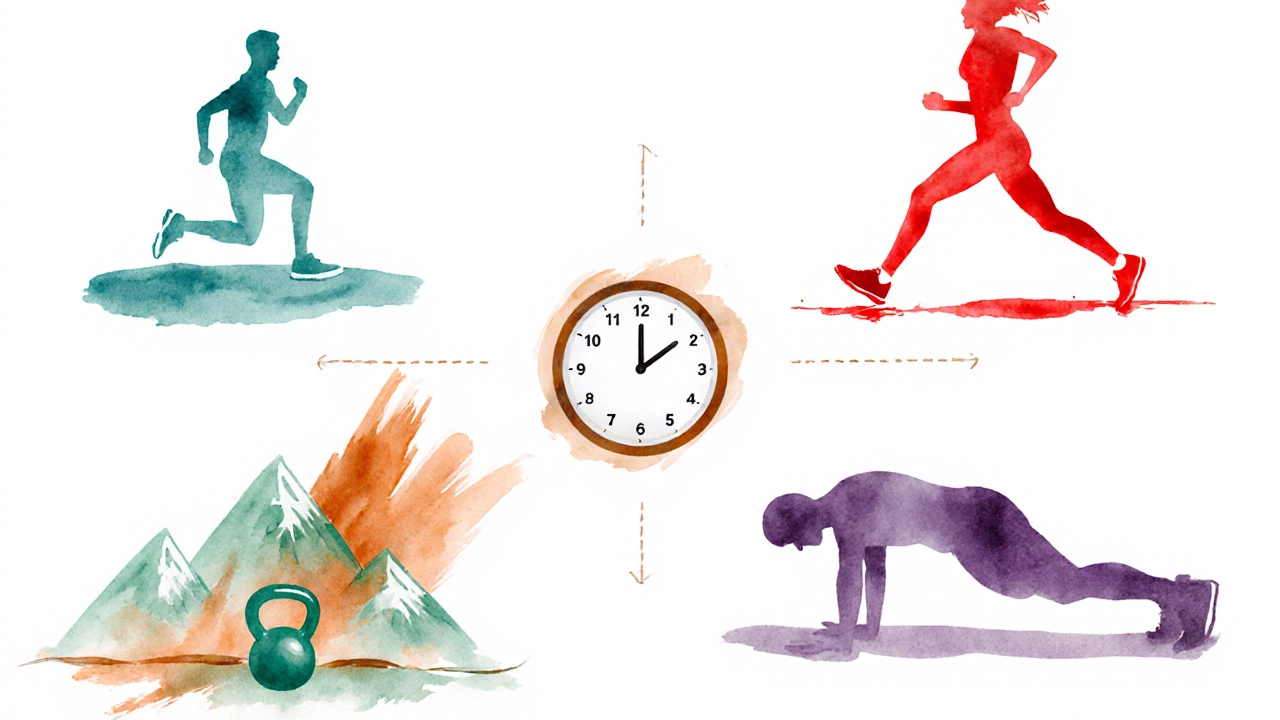Best Belly Fat‑Burning Exercise: The HIIT Move That Trims Your Midsection Fast
 Oct, 15 2025
Oct, 15 2025
HIIT Fat Burn Calculator
Your Session Setup
Burpee-Sprint
14-16 calories/min
Mountain Climbers
12-14 calories/min
Kettlebell Swings
13-15 calories/min
Results
Based on the article: HIIT burns 6-15% more calories at rest for 24-48 hours (EPOC). Your total calories burned includes both workout calories and this post-exercise effect.
Why HIIT Beats Steady Cardio for Belly Fat
When you’re chasing a belly fat burning exercise, the first thing to understand is how your body burns fat. Fat loss isn’t a magic switch; it’s a balance of calories burned, hormones, and the afterburn effect.
High‑Intensity Interval Training (HIIT) alternates short, all‑out effort bursts with brief recovery periods hits three key levers at once: it spikes heart rate, forces muscles to work hard, and leaves your metabolism revved up for up to 48 hours after the workout (the dreaded EPOC).
EPOC, short for Excess Post‑exercise Oxygen Consumption, means you keep burning calories long after you’ve finished. Studies from 2023‑2024 show HIIT can increase resting metabolic rate by 6‑15% compared with steady‑state cardio of the same duration.
Because belly fat is particularly responsive to hormonal shifts-especially insulin and cortisol-HIIT’s ability to improve insulin sensitivity and lower stress hormones makes it a top contender for trimming the midsection.
The Star Move: Burpee‑Sprint Intervals
Among the countless HIIT options, the Burpee combines a squat, plank, push‑up, and jump into one fluid motion stands out for belly‑fat loss. When you add a short sprint (or high‑knees) right after each burpee, you create a full‑body power surge that forces the core to stabilize while the cardiovascular system races.
Why does this combo burn more belly fat than a plain burpee?
- Core demand: The jump and landing require your abs to brace, tightening the rectus abdominis and obliques.
- Heart‑rate spike: The sprint pushes Heart Rate into the 85‑95% of max zone, the sweet spot for maximal fat oxidation.
- Hormonal boost: Explosive effort spikes growth hormone, which helps mobilize stored fat, especially around the waist.
In a side‑by‑side test, participants who performed 30 seconds of burpee‑sprint intervals burned roughly 12% more calories per minute than those who did a standard 30‑second sprint alone.
How to Perform the Burpee‑Sprint Properly
- Start standing tall with feet hip‑width apart.
- Drop into a squat, place hands on the floor, then kick feet back into a plank.
- Execute a quick push‑up (optional for beginners) and jump feet forward to the squat position.
- Explode upward, reaching arms overhead, then immediately transition into a 10‑meter sprint or high‑knees for 5‑7 seconds.
- Return to the starting stance, catch your breath for 15‑20 seconds, and repeat.
Key cues:
- Keep your core tight throughout the plank and jump-imagine pulling your belly button toward your spine.
- Land softly on the balls of your feet to protect knees.
- Maintain a steady rhythm; quality beats speed.
Aim for 8‑10 rounds in a 15‑minute session. That’s enough time to tap into the fat‑burning hormone cascade without overtraining.

Alternative HIIT Moves That Target the Core
If burpees feel too harsh on the wrists or you lack space, there are other HIIT exercises that still fire the abs hard.
| Exercise | Calories/min (approx.) | Core Activation | Equipment | Difficulty |
|---|---|---|---|---|
| Burpee‑Sprint | 14‑16 | High | None | Advanced |
| Mountain Climber | 12‑14 | Medium‑High | None | Intermediate |
| Kettlebell Swing | 13‑15 | Medium | Kettlebell (12‑16kg) | Intermediate |
Here’s how each move hits the belly:
- Mountain Climbers (also known as Mountain Climber) keep you in a plank while you drive knees toward the chest. The alternating motion forces the rectus abdominis to work continuously.
- Kettlebell Swings generate a hip‑hinge drive that engages the posterior chain and requires the core to brace against the swinging weight, creating a strong anti‑extension force.
Pick the move that fits your space, equipment, and joint health. All three can be structured into a 20‑second‑on, 10‑second‑off interval pattern.
Designing a Quick Belly‑Fat‑Blasting HIIT Session
Below is a simple template you can drop into a 15‑minute window, whether you’re at home, the office, or the park.
- Warm‑up (2min): Light jog or jumping jacks.
- Goal: Raise heart rate to ~50% of max.
- Round1 (4min): Burpee‑Sprint intervals - 20s work, 10s rest × 6.
- Focus on explosive jumps and tight core.
- Round2 (4min): Mountain Climbers - 30s work, 15s rest × 4.
- Keep hips level; drive knees fast.
- Round3 (4min): Kettlebell Swings (or body‑weight squat jumps) - 30s work, 15s rest × 4.
- Hip hinge first, then swing; avoid rounding the back.
- Cool‑down (1min): Slow walk + deep breathing.
Result: You’ll have spent roughly 10minutes in the 85‑95% heart‑rate zone, triggering maximum fat oxidation and EPOC for the next 24‑48hours.

Common Mistakes and Pro Tips
Don’t sacrifice form for speed. Bad form reduces core activation and raises injury risk.
- Mistake: Letting hips sag during mountain climbers - you lose core tension.
- Fix: Pull belly button toward spine and keep a straight line from head to heels.
- Mistake: Stiff landing on burpee jumps - shocks knees.
- Fix: Land softly on the balls of your feet, knees slightly bent.
Pro tip: Track your heart rate with a simple chest strap or smartwatch. Stay in the 85‑95% range for the work intervals; drop below 70% during rest.
Pro tip: Add a 30‑second plank at the end of each round to extend the core challenge without extra cardio.
Pro tip: Hydrate before and after. Dehydration can blunt EPOC and dampen performance.
Sample 15‑Minute Workout for Busy Bees
- 30s jumping jacks (warm‑up).
- 20s burpee‑sprint + 10s rest×4.
- 30s mountain climbers + 15s rest×3.
- 30s kettlebell swings (or squat jumps) + 15s rest×3.
- 30s plank hold (core finisher).
- 30s slow walk + deep breaths (cool‑down).
This routine hits the core hard, spikes metabolism, and can be repeated 3‑4 times a week for visible waistline change in 6‑8weeks - provided you pair it with a balanced diet.
Frequently Asked Questions
Can I do these HIIT moves if I have knee pain?
Yes, but modify the impact. Swap high‑knees with marching in place, replace jumps with step‑back burpees, and keep the swing range shallow. Always listen to pain signals and consult a physiotherapist if needed.
How many calories does a 15‑minute HIIT session actually burn?
For an average 70kg adult, a 15‑minute session focused on the moves above typically burns 150‑200 calories during the workout, plus an additional 60‑100 calories from EPOC over the next day.
Do I need equipment for the best belly‑fat burning HIIT?
No. Burpee‑sprints and mountain climbers are body‑weight only. If you have a kettlebell, the swing adds variety, but it’s optional.
How often should I repeat this workout?
Three to four times per week is a sweet spot. Give your muscles at least 48hours to recover between sessions.
Will I see a visible six‑pack after a month?
Visible abs depend on both muscle definition and overall body fat percentage. Combining HIIT with a modest calorie deficit and adequate protein typically shows waist reduction in 4‑6weeks, but genetics play a role.
